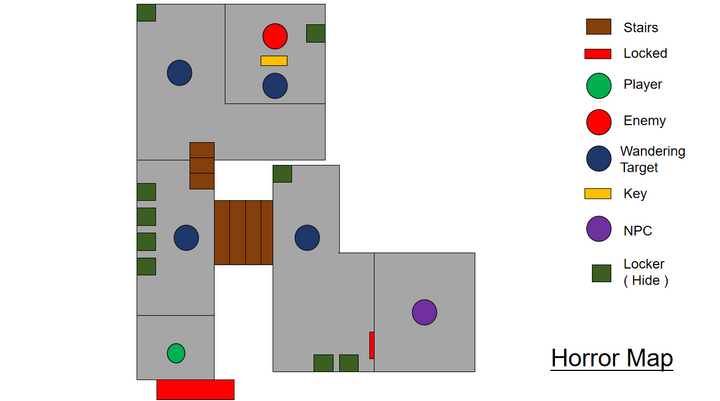Map
This is an unfinished map of another Level project of mine, Welter. After completing Welter, I thought why can't I improve my horror game function with more diversity and complexity? So this new Level "Hellway" was born.

Designs
Hellway, as a branch of my another project - welter, to make it interesting, I mainly drew inspiration from the mechanics of the Outlast series. I need an enemy that will chase the player, constantly creating a sense of urgency, while also providing lockers similar to Outlast for players to hide in. The puzzles are also simple key-finding tasks because the enemy already puts a lot of pressure on the player. If the puzzles were too complex, the game's difficulty would increase significantly.
Mechanisms
Enemy AI
CHASE & CATCH

The enemy will begin chasing the player once they come into view, and unless the player creates a significant distance, the enemy will continue to follow them.
Additionally, if the player hides in a locker in front of the enemy, the enemy will open the locker and kill the player instantly.

PATROLLING

To create a sense of pressure, I set up four different patrol points on the map. The enemy will stay at each point for 5 seconds before moving to the next one to investigate.
Players need to pay attention to the patrolling enemy during their exploration to avoid being ambushed.


HEARTBEAT
To help players better knowing the enemy's location, I included the sound of the enemy's heartbeat instead of footsteps, as I believe the heartbeat creates a greater sense of pressure.
With this heartbeat sound, players can determine the enemy's position based on the volume of the heartbeat in the left and right channels.
Player Mechanisms
FOOTSTEPS
In the game, players have three different movement modes: running, crouching, and walking.
To make the game more realistic, I have added footsteps with different frequencies for each type of movement. This also allows players to more easily distinguish their current state ( since there is a stamina limit for running ).

PEEKING

The leaning mechanic, commonly used in horror games, allows players to peek left and right while behind cover, enabling them to monitor enemy movements without being seen.
This mechanic provides a sense of reassurance for players (being able to see the enemy), while also creating an atmosphere where they must proceed with caution.

HIDING

Similar to Outlast, the game features lockers where players can hide. Upon entering a locker, the player's flashlight will automatically turn off to prevent being detected by enemies.
If the player enters the locker out of the enemy's sight, the enemy will lose track of them and proceed to investigate the area near where they last saw the player.

FLASHLIGHT

A regular flashlight that can be turn on and off, but it will sway as the player moves their camera, making it feel more realistic.
Level Mechanisms
LIGHT SWITCH

A switchable light that players can turn on and off at any time, allowing them to hide in the darkness when needed.
This adds to the atmosphere and realism of the game.


JUMP SCARE

The classic jump scare is used once again, but this time it also serves as a quest guide.
It informs the player that someone is nearby, prompting them to investigate further, eventually leading them to discover the "finding quest" – a locked door.

CUT SCENE
A brief cutscene introduces a new character while incorporating some sudden, sharp music to create a jump scare effect.

FLICKERING LIGHT

Flickering lights serve as a direct visual cue, guiding the player while also signaling that danger may be nearby.
It's both a quest hint and a warning.
Narratives

A how to play guide to show the player the keys for mechanisms

A short narrative to briefly explain the background story